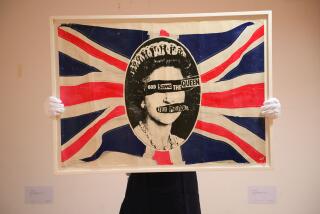Sir Eduardo Paolozzi, 81; Sculptor Was a Co-Founder of British Pop Art Movement
Sir Eduardo Paolozzi, a sculptor and printmaker who helped found the British Pop Art movement of the 1950s, has died. He was 81.
Paolozzi died in his sleep April 22 in a London hospital, said Ben Lawrence of the Flowers East Gallery in London, which represented him. Paolozzi had been in failing health after suffering a stroke, Lawrence said, but had attended the opening of an exhibit of his sculpture at the gallery four days before his death.
Born in Edinburgh, Scotland, of Italian parents, Paolozzi settled in London and had his first solo exhibit there at 23. His early works were witty collages that he made from magazine cutouts of tuna fish cans, screen idols, cartoon characters and other staples of middle-class culture. He considered those images as metaphors for the dreams of the masses. Critics later linked them to the start of the British Pop Art movement.
In 1952, Paolozzi helped form an association of British artists who were working along similar lines. They called themselves the Independent Group and included Richard Hamilton, William Turnbull and Peter Blake.
At their first public gathering, Paolozzi gave a lecture illustrated with a slideshow of his collages, where cars, kitchen appliances and other mass-produced objects were treated as icons of popular culture. The British art critic Lawrence Alloway, who was associated with the group, recognized an art movement in the making and named it Pop.
Paolozzi also sculpted robot-like bronze figures that appeared to be part human and part machine. He created textile designs and mosaics as well.
He is perhaps best known for a huge, flowing mosaic with Pop Art imagery that he designed for the Tottenham Court Road subway station in London in the 1970s. Other public works by Paolozzi were sculpture commissions, including a 1997 bronze of Sir Isaac Newton that stands outside the British Library.
Through much of his career, Paolozzi was a teacher of ceramics, textile design and sculpture, primarily at the Royal College of Art in London and the Kuenste in Munich.
His work was included in solo and group exhibitions across Europe and in the United States, including the 1984 exhibit âThe Automobile and Cultureâ at the Museum of Contemporary Art in Los Angeles.
Paolozzi was elected to the Royal Academy in 1979 and knighted in 1989.
During his childhood in Scotland, Paolozziâs parents expected him to go into the family business, making and selling ice cream. He helped out with the work, but was more interested in the labels, packaging and advertisements. He used product labels for some of his early collages.
His father, who admired the politics of Italyâs Benito Mussolini, sent Paolozzi to a fascist youth camp in Italy for several summers. After Italy entered World War II, he and his father were sent to an internment camp as enemy aliens in 1940. Paolozziâs father and grandfather were being transported to Canada when their ship was torpedoed and sank. Both died.
Released from internment camp, he attended Edinburgh College of Art, but was drafted into the Pioneer Corps, an auxiliary of the British Army, in 1943. He served for about one year, and on discharge, he entered the Slade School of Art in England. He did not graduate but moved to Paris, where he lived from 1947 to 1949.
Returning to London, Paolozzi married Freda Elliot, a textile designer, in 1951. They had three daughters, who survive him; their marriage ended in divorce.
More to Read
The biggest entertainment stories
Get our big stories about Hollywood, film, television, music, arts, culture and more right in your inbox as soon as they publish.
You may occasionally receive promotional content from the Los Angeles Times.








